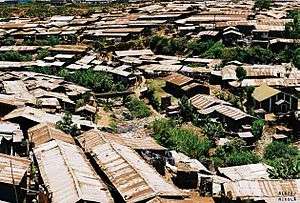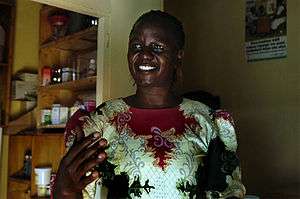Carolina for Kibera

Founded in 2001 by Rye Barcott, Salim Mohamed, and the late Tabitha Atieno Festo, Carolina for Kibera is a 501(c)(3) international non-governmental organization based in the Kibera slum of Nairobi, Kenya. CFK has an office and youth center in Kibera, as well as support services based at the Center for Global Initiatives (CGI) at The University of North Carolina at Chapel Hill. A pioneer of grassroots participatory development, CFK leads a community based sports program, girls' center, medical clinic, and waste management program.
Purpose
Run by Kenyans and advised by American and Kenyan volunteers, CFK's primary mission is to promote youth leadership and ethnic and gender cooperation in Kibera through sports, young women's empowerment, and community development. Additionally, CFK works to improve basic healthcare, sanitation, and education in Kibera.
Philosophy
CFK's philosophy is grounded in the concept of participatory development. Solutions to problems involving poverty are possible only if those affected by it drive development. Concerned outsiders can help by mobilizing communities, advising, networking, and providing resources. Ultimately, however, the community possesses the knowledge and motivation that are necessary to solve its own problems.
Awards and impact
Time Magazine named CFK a "Hero of Global Health" in 2005.[1] Time for Kids featured CFK on the cover of its March 30, 2007 edition.[2] In 2004 Canadian Musician Sarah McLachlan concluded her award-winning music video “World on Fire” with footage of CFK’s soccer tournaments and medical clinic in Kibera. Two years later CFK published LIGHTBOX: Expressions of Hope from Young Women in the Kibera Slum. This powerful book of narratives and photographs from disposable cameras gives voice to the young and courageous women of CFK's Binti Pamoja (Daughters United) Center. [3] In 2007 then Senator Barack Obama visited CFK’s youth center and gave a landmark speech calling for ethnic unity and education in Kibera.[4] CFK played a crucial role in providing emergency aid during the Kenyan post-election violence in 2008, and for its efforts the Oklahoma City National Memorial and Museum honored CFK as its recipient of the Reflections of Hope Award in a ceremony with the former ABC World News Anchor Bob Woodruff and his wife Lee.[5]
History

CFK was founded by Rye Barcott (then an undergraduate at UNC) to help prevent ethnic and religious violence in Kibera through a community-based sports program. In the summer of 2001, Barcott teamed up with Salim Mohamed who was managing the Information and Management Department of the Mathare Youth Sports Association in another informal settlement in Nairobi. Barcott also reunited with the late Tabitha Atieno Festo, a registered nurse and resident of Kibera who had established a small medical clinic from a grant of $26 that Barcott had given her the previous summer to sell vegetables. CFK received its initial funding from hundreds of American citizens in addition to a $30,000 start-up grant from the Ford Foundation. A year later, two undergraduates from the United States, Karen Austrian and Emily Verellen, volunteered in Kibera with CFK and helped young women in Kibera create CFK’s third program, The Binti Pamoja (Daughters United) Center, establishing a safe space for young girls to address issues unique to them. Youth in Kibera subsequently developed the Taka ni Pato (Trash is Cash) and Base of the Pyramid programs in 2005 in order to address the dearth of employment opportunities in Kibera.
External links
References
- ↑ http://www.time.com/time/2005/globalhealth/transcripts/110305moreheroes.pdf
- ↑ "Time For Kids" Cover Story
- ↑ LIGHTBOX: Reflections of Hope from Young Women in the Kibera Slum © 2006
- ↑ "Associated Press", Senator Obama Visits Nairobi Slum, August 27, 2006
- ↑ Oklahoma City National Memorial 2008 Reflections of Hope Recipient